Cleaning ventilation air ducts: effective methods and procedures for cleaning the ventilation duct
Heavy, stale air is depressing both physically and mentally.Not only the general microclimate of the home, but also the well-being of household members largely depends on the cleanliness and composition of indoor air, isn’t it? But ventilation does not always help to establish air exchange: due to blockages in the common house ventilation duct or the ventilation pipe of an additional exhaust system, the draft may drop significantly, after which the circulation of air flows will not occur properly.
Routine cleaning of ventilation air ducts is an important procedure, the quality and regularity of which determines the health and even safety of residents. And in places with large crowds of people, industrial premises, medical institutions or catering establishments, cleaning the ventilation system should be carried out even more often and more thoroughly.
In this material, we will look at the reasons why you should not neglect the maintenance of the ventilation system, talk about effective ways to clean ventilation ducts and air ducts, and figure out whether it is possible to clean up the ventilation shaft yourself.
The content of the article:
Why is air duct cleaning necessary?
Undoubtedly, clean air is one of the foundations of human life. Natural and forced ventilation promote air exchange in the room, making staying in the apartment comfortable and safe.
However, an increase in the amount of dirt deposits inside the air ducts inevitably leads to the migration of debris and pathogens into the home itself. Unwanted particles move into the apartment and quietly poison the health of all inhabitants.
And after removing dirt from the walls of the shaft and effective disinfection, the air entering the apartment does not bring with it harmful suspensions or pathogenic bacteria. Natural ventilation and systems with forced air extraction begin to work more efficiently, and the equipment itself is less subject to wear.
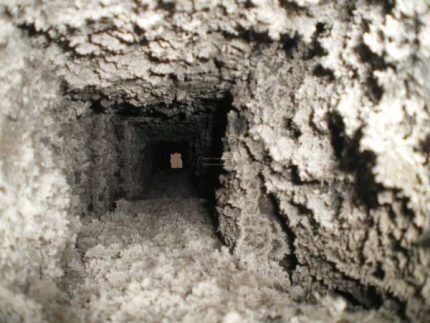
Contaminated ventilation is fraught with extremely undesirable consequences:
- Increasing the level of fire hazard due to the accumulation of sufficiently flammable particles: dust, cobwebs, layers of fat.
- Reduced efficiency of air inflow and outflow due to a decrease in the diameter of the air duct.
- More rapid wear of ventilation devices due to increased load on motors and constant overheating of working units.
- Acceleration of the formation of subsequent mud deposits: in every place where even a small amount of debris has accumulated, new dirt will settle faster.
- Deterioration of the general microclimate in the room due to poor air circulation, increased humidity and normal temperature.
- Negative impact on human health due to an increase in the number of pathogens bacteria, fungi and allergens.
In addition to the direct impact on health, dirty air with low oxygen content provokes a decrease in performance and accelerates fatigue.Therefore, ventilation ducts need to be cleaned not only at home: in offices and other premises with a large number of people staying, scheduled maintenance and disinfection must be carried out more often.
Types of Air Duct Pollutants
Exhaust and supply air ducts and ventilation ducts are the main parts of the ventilation system that require careful maintenance.
Gradually, various contaminants settle on their surfaces, which significantly affect the functioning of the entire exhaust system.
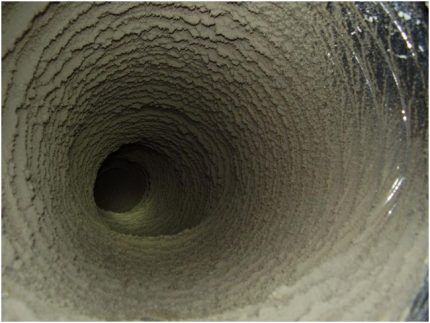
How to clean household ventilation ducts depends largely on the types of contaminants filling the air ducts.
The main ones remain:
- normal dust and dirt, penetrating into the room and shaft from the street;
- rust and other deposits, which over time can concentrate on metal surfaces due to increased humidity levels;
- fungi and mold;
- water depositswhich is formed due to the movement of moist air masses or the formation of condensation when the air temperature changes;
- fatty sediments, the source of which is heat treatment of food products;
- colonies of microorganisms, developing in a favorable humid environment.
In specialized institutions, for example, laboratories or production workshops, particles of reagents or chemicals may settle on the inner surface of ventilation units, which, due to their nature, require a special approach to neutralization and removal.
A separate and rather complex subtype of pollutants are deposits after a fire or a flood.Combustion products require immediate removal from the shaft and air ducts, since inhalation of these substances has a very detrimental effect on human health.
Consequences of the flood are no less insidious: the abundance of humid air and condensation contribute to the growth of fungal colonies inside the ventilation system. Spores easily move through air ducts, penetrating into living spaces, after which the development of mold continues directly in the apartment - on the walls, ceiling of living rooms.
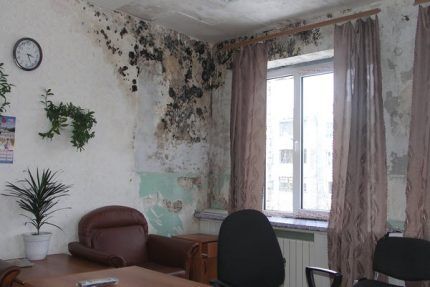
Exhaust ventilation ducts become dirty more slowly than supply air ducts. In addition to street dust, the latter retain allergens, for example, pollen, chemical compounds from exhaust gases or emissions from industrial enterprises.
The most polluted ventilation units
The air ducts used to build a ventilation system vary in size, material, shape, design and connection method. However ventilation pipes have a fairly large cross-section and a straight direction, and air with unwanted suspended matter passes through these areas most easily. Therefore, the direct ventilation duct is least susceptible to clogging.
It is much more difficult to deal with dirt in certain system nodes, which, due to their configuration, trap more debris.
These elements include:
- ventilation outlets;
- tees and crosses;
- flexible inserts and rectangular wefts;
- areas near filters;
- valves;
- diffusers and gratings;
- adapters, etc.
It is these elements that need to be given maximum attention when cleansing.
It is also worth considering that it is quite difficult to treat these areas without special equipment, so you cannot do without calling a team of specialists.
Signs that ventilation ducts need to be cleaned
A visual inspection using special video surveillance devices is the surest way to personally verify the amount of debris and the need to clean the air ducts.
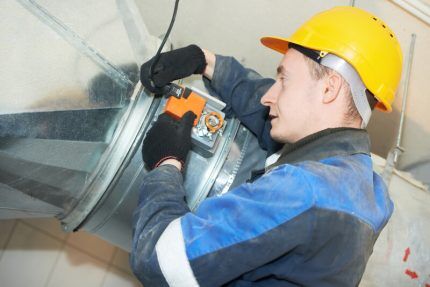
However, even without special equipment, you can understand that the ventilation system needs to remove accumulations of dirt.
The following signs indicate that it is time to rid the air ducts of dust, grease and other pollutants:
- The microclimate in the premises has worsened—it feels stuffy.
- The strength of drafts generated when windows and doors are opened has decreased significantly.
- Dust began to accumulate more often on furniture and other surfaces.
- The draft in the ventilation duct has dropped significantly.
- On ventilation grille and the areas around it appear cobwebs and traces of dust.
If the homeowner observes at least some of the phenomena described above, it is worth conducting a visual diagnosis of the ventilation ducts. This can be done through the inspection hatch or, if it is missing, by removing the ventilation grille.
Methods for cleaning ventilation ducts
Most owners prefer to do home maintenance themselves, without resorting to the help of specialists. However, cleaning air ducts requires both a certain skill and a special and quite expensive equipment. Therefore, owners who are thinking about how to clean their home ventilation duct should still contact a company that has the appropriate license and permission to carry out this work.
Specialists will organize the procedure in a truly high-quality and efficient manner, and will also take samples of contaminants. Analysis of samples will allow us to determine the presence of pathogenic flora in the system and select the optimal disinfection agent.
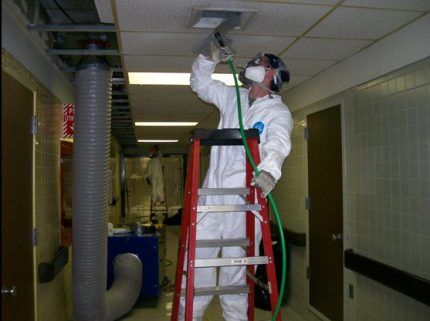
Using video technology to diagnose canals will make it possible to choose the most suitable method for cleaning mines.
Method #1 - mechanical cleaning
An effective cleaning method, most often used to maintain vertical channels. It is carried out by physically scraping deposits from the walls of the air ducts.
Convenient for removing simple stains:
- dust;
- cobwebs;
- small stones;
- waste products of birds and rodents.
In fact, the cleansing procedure can be carried out either completely manually or automatically. The method is dry, as it does not involve the use of detergents or any other chemicals.
However, this method is not very suitable for neutralizing fatty deposits, since accumulations of this pollutant are very difficult to remove from the surfaces of the canal. Another disadvantage of this method is that it is extremely inconvenient to use in ventilation systems with a complex configuration, an abundance of bends and branches.
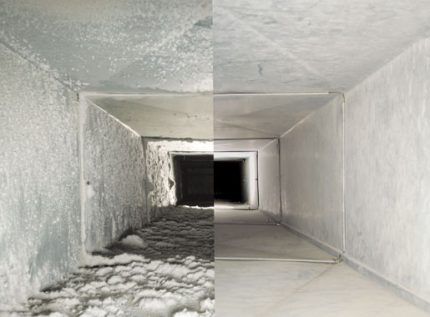
For mechanical cleaning, both simple and quite complex devices are used:
- Wire rope with wire brush removes deposits well from surfaces. To increase efficiency, the design can be supplemented with an electric drive, thanks to which debris removal occurs more intensively.
- Combination device with brushes and vacuum cleaner makes it possible to simultaneously remove plaque and absorb its particles, so that they do not spread through the ventilation duct.
If mechanical cleaning occurs without the use of a vacuum cleaner, the scraped debris can be removed naturally, in which the air flow carries the dirt with it.
When cleaning vertical channels in residential buildings using a brush and a weight on a cable, debris may fall into a special pocket of the shaft or settle in the opening at the entrance to the apartment. In the latter case, it must be collected to avoid the spread of dirt into the home. Therefore, it is more effective to use an additional vacuum unit, which is separately connected to the air duct and sucks out all the dirt.
Read more about the process of cleaning the ventilation shaft in an apartment building. reviewed here.
Method #2 - dry cleaning with foam
The method is effective for neutralizing fatty plaque, which is difficult to mechanically influence. The method is most in demand in catering establishments, where complex air ducts of kitchen hoods are most susceptible to the constant settling of fat particles.
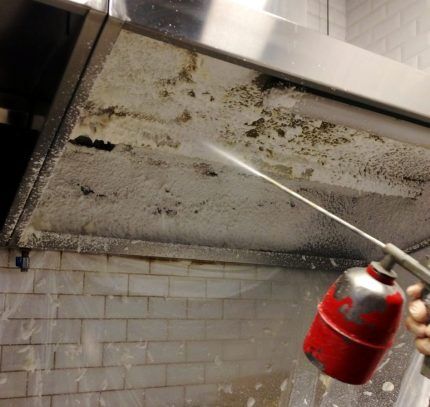
During the cleaning process, a special composition is sprayed inside the air duct, which breaks down fat. The plaque exfoliates and is torn away from the surface, after which its particles are carried away by air masses or sucked out with a vacuum cleaner.
Quite aggressive alkaline compounds are used as detergents. Some of them, in addition to cleaning, also have disinfecting properties. The concentration of the reagent is selected by a specialist, based on the degree of contamination of the system.
If the foam does not kill germs, additional cleaning is carried out during the cleaning process. air duct disinfection. The choice of disinfectant also remains with the company employee. To maximize the effectiveness of the pathogen destruction procedure, it is advisable to take contaminant samples to determine the types of microorganisms inhabiting the air ducts.
Method #3 - combined cleansing method
The method involves the use of mechanical devices + special cleaning foam. This tandem allows you to achieve good results in the presence of various types of contaminants.

The procedure can be either completely manual or automated, in which vacuum devices are used to extract residual dirt.
Method #4 - cryogenic blasting
At its core, this relatively new method is a type of chemical purification. However, blasting deserves special attention due to its effectiveness and gentle action. The process uses so-called dry ice, which has optimal properties for cleaning walls.
The unit supplies dry ice into the air duct.The substance, in contact with the walls of the ventilation duct, almost instantly begins evaporation, during which micro-explosions are produced. Thanks to them, the contaminant deposits are separated from the walls, but the surface of the shaft itself is not damaged. When dry ice disintegrates, it is converted into carbon dioxide, which leaves the channel with a stream of fresh air.

Gentle cleaning, safety and environmental friendliness make cryogenic blasting the optimal choice for use in residential premises and catering establishments.
Air duct cleaning technology
In fact, cleaning ventilation ducts and air ducts takes place in two stages. The first one is held inspection of internal surfacesto assess the degree of contamination of the mine. For this purpose, special equipment is used, equipped with cameras and small spotlights.
The image is displayed on a computer screen or other equipment, so the operator can assess the scope of upcoming work. Additionally, waste samples are taken for subsequent analysis for the presence of pathogenic organisms.
At the second stage, activities are directly carried out cleaning work, the course of which depends on the chosen cleansing method. When mechanically cleaning the vertical ducts of a residential building, specialists run a cable with a weight and a special brush into the shaft, which effectively removes deposits and large blockages from the walls of the air duct. Before connecting special equipment, workers close the valves, inlets and outlets of the ventilation system.
If vacuum units are used during the cleaning process, they are connected to one of the air duct outlets. After this, the cleansing procedure begins, which may include only mechanical action or also the use of chemical detergents.

If necessary, after cleaning, disinfection is carried out using products selected by a specialist. These may be preparations based on peracetic acid, hydrogen peroxide or other pathogen-neutralizing substances.
How to clean the ventilation duct yourself?
Independent cleaning of air ducts in a residential building is a rather complicated procedure, which is still best left to professionals. It is extremely difficult for a home owner without special equipment to remove contamination efficiently without compromising the integrity of the system.
Also, ventilation systems are common property, so the management company must be responsible for their maintenance. Physically, a resident can only clean the area of the mine adjacent to his apartment, which will not be enough to restore the full functioning of the ventilation.
However, it is still possible to complete some of the work. It is necessary to first warn your neighbors about the upcoming cleaning, since noise will be created during the work, and particles of debris may fly into the living space from the ventilation openings on the floors below.
Before starting work, you also need to take care of personal protective equipment: a respirator, strong gloves, goggles.It is better to cover the floor under the ventilation hole with rags, since during work a large amount of debris may spill out.
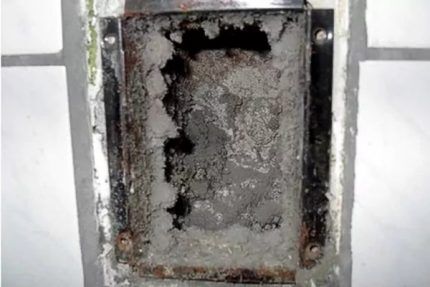
The procedure for cleaning the ventilation duct is as follows:
- Remove the ventilation grille or dismantle exhaust fan. Rinse the grille or clean the hood according to the instructions.
- Visually inspect the ventilation duct by illuminating the cavity with a flashlight.
- If there is large debris in the shaft, such as stones, remove it by hand as carefully as possible.
- Using a metal brush or spatula, carefully scrape the deposits from the sides of the shaft.
- Remove remaining dirt using a vacuum cleaner without using brushes. However, this particular stage is quite unsafe; below we will explain why.
- Wipe the cleaned walls with a damp cloth.
- Replace the ventilation grille or reassemble the exhaust fan.
Using an ordinary household vacuum cleaner in the process of cleaning the ventilation duct is an extremely dubious step, which most apartment owners still resort to. The danger of such cleaning is that bacteria and fungi from the mine can easily bypass the filters of the equipment and enter the apartment in large quantities. It is also forbidden to use the vacuum cleaner in the blowing mode, since all the rubbish through the ventilation holes on other floors will simply end up in other people’s apartments.
In addition to blowing with a vacuum cleaner, when cleaning the ventilation duct yourself, it is prohibited to use special chemicals for cleaning and disinfection.Without knowledge and skills, an ordinary user will not be able to correctly calculate the concentration suitable for spraying. A composition that is too aggressive can damage the walls of the air ducts or cause poisoning to residents. The only substance allowed for household cleaning is dry ice.
Conclusions and useful video on the topic
In the video below, the master talks in detail about the types of air ducts and types of connecting fittings:
The process of cleaning air ducts using electric flexible shaft equipment is demonstrated below:
A detailed procedure for all stages of cleaning ventilation in the food unit is shown by cleaning company specialists:
Cleaning the air ducts of the ventilation system in domestic conditions should be carried out at least once every one to two years. For industrial enterprises and catering establishments, scheduled cleaning should be organized several times a year. This important procedure cannot be neglected, since dirt deposits in the ventilation duct can have an extremely negative impact on the health of residents and on the operation of exhaust or climate control equipment.
However, due to the complexity of disassembling the structure and the extremely low quality of self-cleaning, it is better to trust the maintenance of air ducts to employees of specialized companies. Serious equipment, effective cleaning and disinfection reagents, experience and skills allow teams to quickly and efficiently deal with all types of contaminants in air ducts.
Have you recently done some DIY air duct cleaning and want to tell others about it? Or are you an employee of a company specializing in the cleaning and disinfection of ventilation and air conditioning systems, and want to supplement the above material with useful information? Write your comments and recommendations, ask questions - the comment form is located below.



